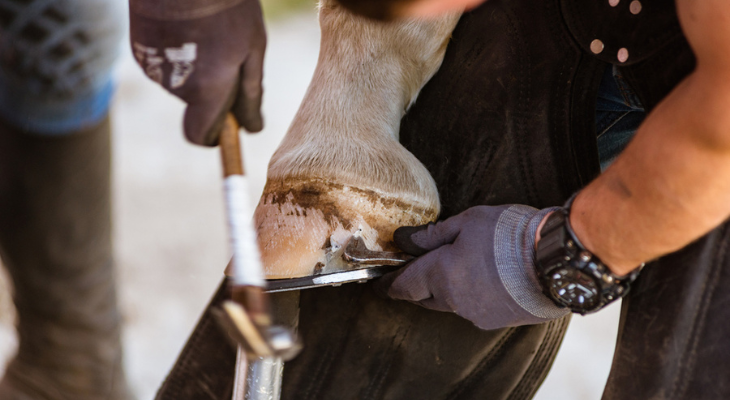March Newsletter: How Your Veterinarian Can Treat Corns in Horses
- Created in Newsletter Library

How Your Equine Veterinarian Can Treat Corns in Horses
Forelimb lameness could be a sign that your horse has a corn on its foot. Corns can cause mild to moderate pain and make walking a little difficult. Fortunately, your equine veterinarian offers treatments that relieve pain and help your horse's feet heal.
What Are Corns?
Corns form between the layers of your horse's soles due to increased pressure on the foot. If you've ever had a bruise on your foot after stepping on a rock or Lego, you have an idea of how uncomfortable corns can be for horses.
The area between the hoof wall and bars in the heel is a common site for corns. The bars, located at the back of the foot, provide traction and support for the hoof. Corns can affect any of your horse's hooves but typically develop in the front feet.
Corn types include:
- Dry. If your horse has a dry corn, you may notice a red area on the sole due to bleeding between the sole layers.
- Wet. Your horse has a "wet" corn if fluids accumulate between the layers of the sole.
- Suppurative. Suppurative corns are infected and contain pus.
In addition to a red mark on the sole, signs and symptoms of corns may include:
- Lameness. Although corns aren't always painful, they may be the reason why your horse is walking gingerly.
- Warmth. The hoof may feel warm when you touch it if your horse has a corn.
- Increased Pulse Strength. The pulse in your horse's foot may feel stronger than normal due to a corn.
- Tenderness. Pressing on the corn with a hoof tester may cause pain.
Why Does My Horse Have a Corn?
A corn could form if your horse is overdue for a visit with the farrier. These corns develop when a shoe no longer fits well and applies too much pressure to the foot. Corns may also form due to shoe fit issues, such as shoes that are too small, too tight at the heel, or placed incorrectly.
In some cases, a corn could develop due to pressure from a pebble or piece of ice stuck between the shoe and the foot. PetMD notes that poor hoof growth could affect the fit of the shoe and lead to corns. Poor hoof balance or poor conformation could increase your horse's risk for developing corns.
Corns can affect horses that don't wear shoes too, particularly if they walk on hard, rocky, or rough surfaces. Some horses naturally have thinner or softer soles that bruise more easily, according to The Horse.
How Do Veterinarians Treat Corns?
Reducing pressure on the foot is the key to relieving pain and lameness. After removing your horse's shoe, your equine veterinarian may trim the corn with a hoof knife to decrease pressure on the foot.
Draining helps relieve pressure and pain if your horse has a wet or suppurative corn. After draining, the area will be covered with a dressing or a poultice that promotes further drainage. As your horse heals, your veterinarian may recommend a short period of box (stable) rest.
If your horse is in pain caused by a corn, anti-inflammatory medication may be recommended. Before re-shoeing your horse, your veterinarian may apply materials to the hoof that harden and protect it.
Good preventive measures will help your horse from developing a new corn. Trimming the hooves regularly keeps them balanced and may help prevent new corns. The shape of the horseshoe may need to be changed to reduce pressure on the foot, or your horse may benefit from padding placed under the shoe. Pour-in padding applied directly to the foot may also be helpful.
Your veterinarian and farrier may also suggest a change in shoes if a conformation problem or poor hoof balance is a contributing factor in corn development. Trimming hooves and replacing shoes more often may also be helpful.
Do you think your horse may have a corn? Contact our office and we'll schedule an appointment with the equine veterinarian.
Sources:
United States Eventing Association: Identifying and Treating Corns in Horse Hooves, 11/29/2019
https://useventing.com/news-media/news/identifying-and-treating-corns-in-horse-hooves
PetMD: Corns in Horses, 5/24/2023
https://www.petmd.com/horse/conditions/skin/c_hr_corns
Horse & Rider: Hoof Health: Corns, 10/2/2019
https://horseandrider.com/horse-health-care/horse-life-health-hoof-health/
Equus: Why Hoof Bruises Happen, 2/12/2024
https://equusmagazine.com/lameness/hoof-bruises-happen-29327
The Horse: Horse Foot Bruises, 2/15/2022


